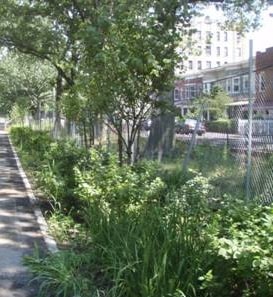Why does stormwater infrastructure matter?


H2 Oh No! from the Center for Urban Pedagogy on Vimeo.
What is green infrastructure?

Green street, improved tree pit – Stratford Ave

Rainwater barrel – private home within Bronx River watershed

Bioswale – Shoelace Park 213th to 211th Street

A green street in the Bronx River sewershed. Photo: Earth Institute, Columbia University.
Who is involved in the Bronx River watershed?
What progress has been made?
This project involves multiple actors, including various city agencies, academic institutions, community organizations, and private homeowners.
The NYC Department of Environmental Protection (DEP) has made stormwater management via green infrastructure one of their primary goals. Their Green Infrastructure Plan includes the Bronx River as one of its twelve priority sewersheds . The Green Infrastructure Program, which converts unused spaces within the right-of-way, such as vacant traffic islands and medians, into rain gardens, is an interagency collaboration between the Department of Transportation, the Department of Parks and Recreation, and the DEP. The New York City Soil and Water Conservation District also lends tremendous support for green infrastructure projects in the Bronx and organizes educational tours. A team from Columbia University headed by Patricia Culligan is researching the effectiveness of the city’s efforts and collecting information regarding best practices. Sustainable stormwater management practices are featured prominently in several of the Alliance’s plans, such as the watershed management plan, greenway plan, and ecological restoration and management plan.
A map of green infrastructure in the Bronx River watershed can be viewed here.
Additional Resources
- S.W.I.M. (Storm Water Infrastructure Matters) Coalition
- Map of green infrastructure in New York City, DEP
- “I love the Bronx: Bioswales”
- “Just How Effective is Green Infrastructure?” The Earth Institute at Columbia University, Blog
- NYC Green Infrastructure Plan and Annual reports (Bronx River spotlight p. 28-29)

